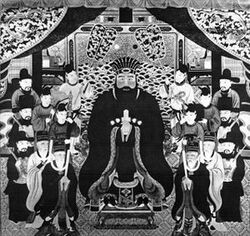Sho En
- Born: 1415
- Died: 1476/7/29
- Titles: 琉球国王 (Ryûkyû-kokuô, King of Ryûkyû)(1469-1476)
- Other Names: 金丸 (Kanamaru)
- Japanese/Chinese: 尚 円 (Shou En / Shàng Yuán)
Shô En was a king of the Kingdom of Ryûkyû, the founder of the Second Shô Dynasty. Prior to becoming king, he was known as Kanamaru (金丸).
Early life and rise to power
Kanamaru was born into a family of peasant farmers on Izena Island[1][2], a tiny island which lies off the northwestern coast of Okinawa Island. It is said that he lost his parents when he was around twenty and undertook to provide for his aunt and uncle, brother and sister, and his wife, whom he married at a very young age[3]. Some sources identify his father as a man named Shô Shoku (in some accounts, King Shô Shoku), of some kind of distant royal ancestry, being related to either the semi-legendary Gihon (r. 1249-1259) or the even more legendary Tenson dynasty.[4]
According to traditional accounts, in one year in which the island had suffered from a particularly severe drought, the rice patties of Kanamaru's family were found to be full of water; accused of having stolen the water, Kanamaru was forced to flee his home, and ended up in 1438 in Ginama, in the northern region (Kunigami) of Okinawa Island[1][2][5].
After several years living in Ginama, there too some type of dispute or disagreement between Kanamaru and his neighbors emerged[3]. Leaving Ginama, he traveled to Shuri, the capital of the Ryûkyû Kingdom, in 1441, and became a servant or retainer to the prince, Shô Taikyû. After Shô Taikyû became king in 1454, Kanamaru was made royal treasurer[3], and was in 1459[2] granted the post of Omonogusuku osasu no soba, a position involving responsibility for matters regarding foreign relations and trade, and oversight of Naha harbor. In traditional accounts, he was also at this time granted territory, and made the lord of Uchima udun;[1][2] Gregory Smits suggests, however, that Kanamaru may have already been lord of Uchima at that time, and it was by recognizing his authority there that Taikyû helped secure his loyalty and aid.[6]
There emerged a difference of opinion between Kanamaru and Shô Toku, who succeeded Shô Taikyû as king in 1461[1][2], possibly over the king's costly military efforts on the island of Kikaigashima[3], leading Kanamaru to leave Shuri and retire to Uchima[1][2]. Shô Toku died shortly afterwards, however, and it is said that in the ensuing discussions among the elder bureaucrats to choose a successor, Kanamaru was selected by popular demand, and thus came to the throne, taking the royal name Shô En[2]. Historian George H. Kerr, however, points out that official histories produced in the following centuries were written with the patronage of Shô En's successors; also that the circumstances surrounding Shô Toku's death remain something of a mystery, and the traditional account may simply indicate that there was a shift in allegiances among the aristocrats and bureaucrats towards Kanamaru, or that those parties in support of Kanamaru simply outnumbered those on the side of the late king[3].
Reign
Shô En thus established the Second Shô Dynasty, taking on the honorary surname granted the kings of Ryûkyû by Ming Dynasty (and later, Qing Dynasty) China. He also banned members of the former Shô lineage from high government office, and from marrying into the lineage of the new dynasty, and took steps to elevate the prestige of his own family. His father came to be honored as King of Izena, and a formal tomb was constructed for Shô En's parents on Izena Island. Shô En also named his sister high priestess, or "noro", of Izena; the lineage of high priestesses descended from her continued until the 20th century[3].
His reign marked the beginning of an institutional shift in the royal government, away from rule by a charismatic or otherwise gifted individual leader, i.e. the king, and towards a more bureaucratic system, with the king at its center.
Shô En's childhood wife is believed to have died, or otherwise separated from Kanamaru, before he rose to prominence at Shuri. He had his first son with his second wife, Yosoidon. Shô En died in 1476, after ruling for only a few years, and was succeeded by his brother Shô Sen'i, to Yosoidon's chagrin. Presently, the high priestess, daughter of the late king and Yosoidon, received a divine message indicating that Shô Sen'i should abdicate in favor of his nephew, son of Shô En, who then took the throne as Shô Shin.
Shô En was originally entombed at a site called Miagemori (見上森), but his remains were moved in 1501 to Tamaudun, newly constructed in that year by Shô Shin, especially for that purpose.[7]
References
This article was written by User:LordAmeth and contributed to both S-A and Wikipedia; the author gives permission for his work to be used in this way.
- ↑ 1.0 1.1 1.2 1.3 1.4 "Shō En." Okinawa rekishi jinmei jiten (沖縄歴史人名事典, "Encyclopedia of People of Okinawan History"). Naha: Okinawa Bunka-sha, 1996. p39.
- ↑ 2.0 2.1 2.2 2.3 2.4 2.5 2.6 "Shō En." Okinawa konpakuto jiten (沖縄コンパクト事典, "Okinawa Compact Encyclopedia"). Ryukyu Shimpo (琉球新報). 1 March 2003. Accessed 30 October 2008.
- ↑ 3.0 3.1 3.2 3.3 3.4 3.5 Kerr, George H. Okinawa: The History of an Island People. Tokyo: Tuttle Publishing, 2000. pp102-104.
- ↑ Gregory Smits, Maritime Ryukyu, University of Hawaii Press (2019), 152.
- ↑ Smits, Maritime Ryukyu, 115.
- ↑ Gregory Smits, Maritime Ryukyu, University of Hawaii Press (2019), 115.
- ↑ Shinzato Keiji 新里恵二 et al. Okinawa ken no rekishi 沖縄県の歴史. Yamakawa Shuppan, 1996. p60.
| Preceded by: Shô Toku |
Reign as King of Ryûkyû 1469-1476 |
Succeeded by: Shô Sen'i |
